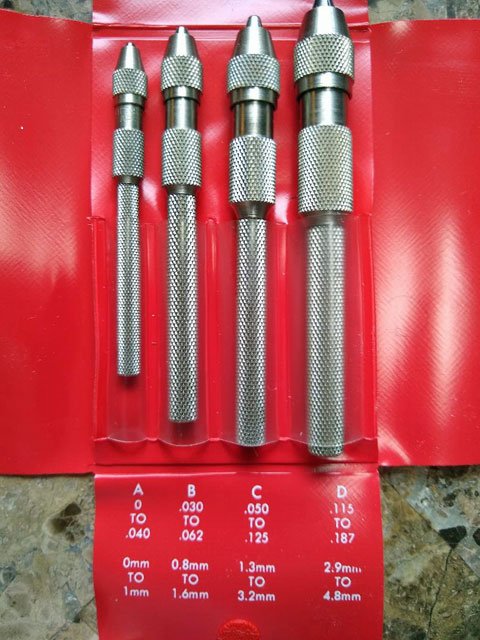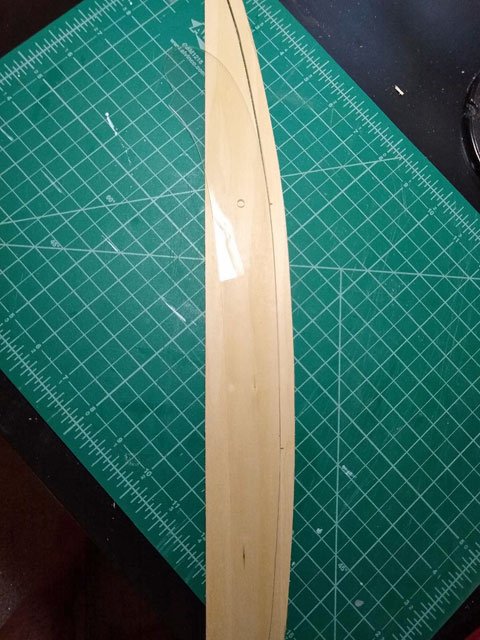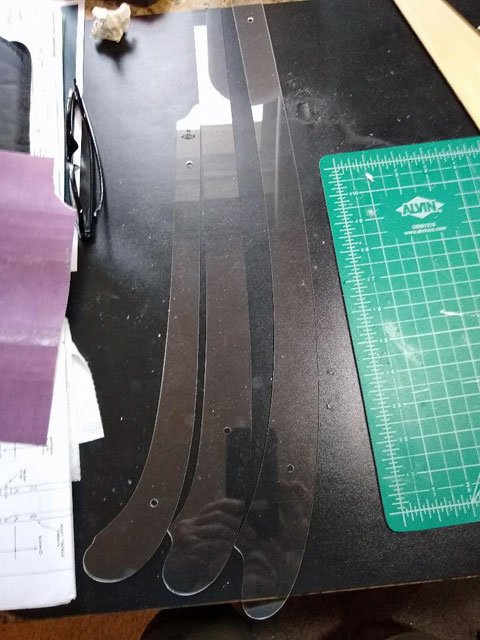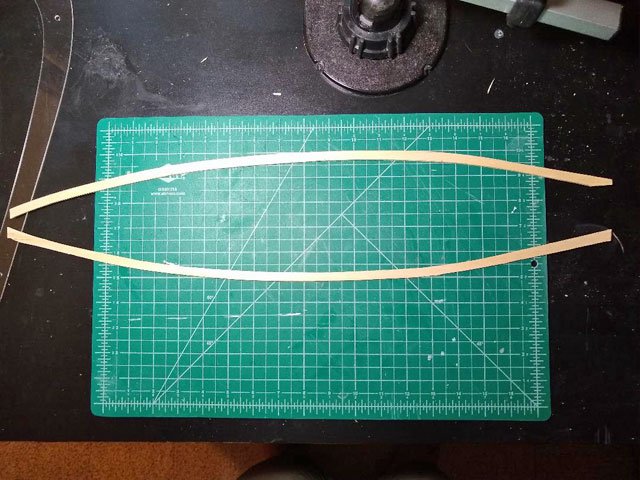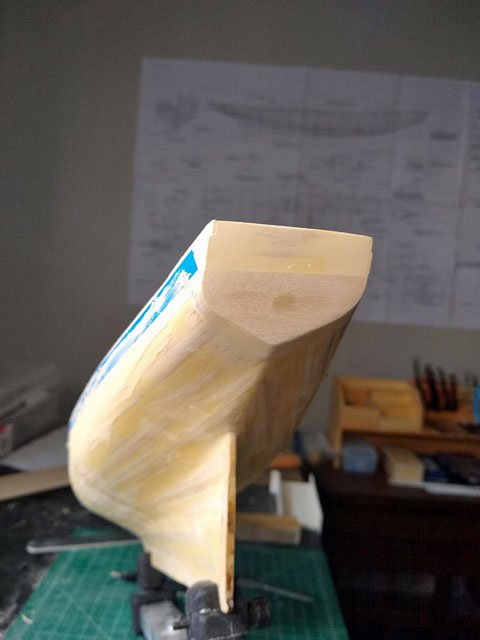-
Posts
1,181 -
Joined
-
Last visited
Content Type
Profiles
Forums
Gallery
Events
Everything posted by CPDDET
-
Decided to go with this set of Starrett pin vices. Thanks to all for sharing your advice and suggestions.
-
Thanks to all for sharing their method on cutting the top rails. After giving it a good deal of thought, I decided I wanted the top rail to be one piece between the bow and stern pieces. I went to a local hobby shop and purchased a 1/16” X 3” X 24” piece of basswood, about $2.50. Having already trimmed the false frames flush with the top bulwark plank, I laid the new piece of basswood on top of the false frames and, using a mechanical pencil, traced the shape of the hull from underneath. This, I think, was much the same way Tector did his. Then I measured the widest part of the rail on the plans and scribed a line parallel to the one I drew. Using ships curves, I cut out one top rail (tough to see the ship curve as its clear plastic). I then used the cut top rail as a template to draw the second top rail and cut that one out. I now have 2 rough cut top rails. Next will be transferring the measurements from the plans to the rough cut top rails for the wider areas and sanding everything to form the finished pieces. Here is a better picture of the ships curves, I believe there are actually 6 pieces in the set.
- 389 replies
-
- bluenose
- model shipways
-
(and 1 more)
Tagged with:
-
While I haven't posted for some time, the work continues. And I will post some pictures shortly. Right now I'm attempting to install the caprails and have run into an issue. The plans call for the caprail to be made from 7/32 X 1/16 stock. However the parts list for this MS2130 kit does not list such a dimension, nor is there such a dimension in the box. How have you other shipwrights dealt with this issue? Dave
- 389 replies
-
- bluenose
- model shipways
-
(and 1 more)
Tagged with:
-
I've reached a point I'm my build where I'm going to need a pin vice and bits. I see Micromark has several different styles so I'm looking for advice / suggestions. Dave
-
Nice work Paul! She looks great.
- 168 replies
-
- 18th Century Armed Longboat
- Model Shipways
-
(and 1 more)
Tagged with:
-
Fine looking work there!
- 168 replies
-
- 18th Century Armed Longboat
- Model Shipways
-
(and 1 more)
Tagged with:
-
While I'm just finishing up the basic hull, I have managed to obtain a copy of LB Jensons book on Bluenose II. The book is a treasure trove of scale drawings for the entire ship. Including hull planking, rigging, deck housings, sail plan and many details. There are even drawings of below deck areas. What a challenge it would be to build a half open hull showing below decks. Way beyond my current skill level.
- 38 replies
-
- bluenose
- model shipways
-
(and 1 more)
Tagged with:
-
Very nice work. I'm following your build closely as I'm just to the point of painting the waterways and hull.
- 38 replies
-
- bluenose
- model shipways
-
(and 1 more)
Tagged with:
-

Have a extra $100.00 to spend......
CPDDET replied to CPDDET's topic in Modeling tools and Workshop Equipment
Looks like a winner. That one will make the list for a future purchase. -
Excellent workmanship
- 168 replies
-
- 18th Century Armed Longboat
- Model Shipways
-
(and 1 more)
Tagged with:
-

Have a extra $100.00 to spend......
CPDDET replied to CPDDET's topic in Modeling tools and Workshop Equipment
I've learned a lot here. Thanks to all! -
Thanks Phil I feel like once I finish and paint the basic hull it will be like a fresh start doing the deck, masts and rigging. Learned a lot thru mistakes while doing the basic hull and can apply what I learned to finishing the model.
- 389 replies
-
- bluenose
- model shipways
-
(and 1 more)
Tagged with:
-
Been awhile since my last update. I now have about 175 hours in the build. After suffering some slings and arrows I will be following Hunt’s practicum more closely. While it’s been a bit busy around the house these past few weeks, I have managed to make some progress. I installed the upper bulwark and sanded all the false frame timbers so they are even with the top of it and put in the hawse timbers. I then did some work on the stern / transom. Not quite finished back there yet. Because of some sloppy sanding on my part, there were small gaps in a few spots between the lower bulwark and the top hull plank. So I carefully taped the lower bulwark just even with the bottom of the scupper openings. Mixed up some Elmer’s wood filler with a few drops of water to get it to the consistency of toothpaste and filled the gaps. Tomorrow I will remove the tape and sand the areas smooth. May have to clean out some of the scupper holes where some wood filler squirted through. Then it will be time to paint the inside of the bulwarks, false frame timbers and waterways. But before I lay a brush on the ship I will follow the advice of more experienced model shipwrights and do some testing. I’m going to try 3 different sealers that were recommended: Delta Ceramcoat, shellac and sanding sealer. I also need to experiment with the ratio of paint to extender to get a “milk-like” consistency.
- 389 replies
-
- bluenose
- model shipways
-
(and 1 more)
Tagged with:
-

Have a extra $100.00 to spend......
CPDDET replied to CPDDET's topic in Modeling tools and Workshop Equipment
Aye matey! -

Have a extra $100.00 to spend......
CPDDET replied to CPDDET's topic in Modeling tools and Workshop Equipment
You're absolutely right about that. I traded in my old analog one for a digital some time ago. Indispensable. -

Have a extra $100.00 to spend......
CPDDET replied to CPDDET's topic in Modeling tools and Workshop Equipment
More good info! -

Have a extra $100.00 to spend......
CPDDET replied to CPDDET's topic in Modeling tools and Workshop Equipment
Thanks for the tip! -

Have a extra $100.00 to spend......
CPDDET replied to CPDDET's topic in Modeling tools and Workshop Equipment
Never fear. The drill may come in the future when the need arises. I'm new to this art and don't yet wish to jump in with both feet. It's much to easy for me to get caught up in "buying rather than building". -

Have a extra $100.00 to spend......
CPDDET replied to CPDDET's topic in Modeling tools and Workshop Equipment
I really don't care for E-books. Just old fashioned I guess. I like the printed page. As stated, this is just a start of a referance library. Of course there will be other sources, such as others build logs and practicums. -

Have a extra $100.00 to spend......
CPDDET replied to CPDDET's topic in Modeling tools and Workshop Equipment
Thank you all for the great advice here., So many tempting tools out there! After giving it some thought I decided to invest in some books on rigging. This is something that I will be attempting quite soon on my current build (also my first build). Spent about $90.00 but it will be a good start for my rigging library. Rigging Period Fore-and-Aft Craft by Lennarth Petersson The Rigging of Ships: in the Days of the Spritsail Topmast, 1600-1720 by R. C. Anderson Rigging Period Ship Models: A Step-by-Step Guide to the Intricacies of Square-Rig by Lennarth Peterson The Art of Rigging by George Biddlecombe The Young Sea Officer's Sheet Anchor: Or a Key to the Leading of Rigging and to Practical Seamanship by Darcy Lever -

Have a extra $100.00 to spend......
CPDDET replied to CPDDET's topic in Modeling tools and Workshop Equipment
Good glass, wether it be filters or lenses, is expensive. -

Have a extra $100.00 to spend......
CPDDET replied to CPDDET's topic in Modeling tools and Workshop Equipment
Well, it looks like I'll order the electric plank bender, some cross lock clamps and a small modelers hammer. That will leave me enough to buy a 77mm circular polarizer for my wide angle lens. Photography is my other hobby. Between that and shipbuilding I'm going to need a lot more garage sales. LOL
About us
Modelshipworld - Advancing Ship Modeling through Research
SSL Secured
Your security is important for us so this Website is SSL-Secured
NRG Mailing Address
Nautical Research Guild
237 South Lincoln Street
Westmont IL, 60559-1917
Model Ship World ® and the MSW logo are Registered Trademarks, and belong to the Nautical Research Guild (United States Patent and Trademark Office: No. 6,929,264 & No. 6,929,274, registered Dec. 20, 2022)
Helpful Links
About the NRG
If you enjoy building ship models that are historically accurate as well as beautiful, then The Nautical Research Guild (NRG) is just right for you.
The Guild is a non-profit educational organization whose mission is to “Advance Ship Modeling Through Research”. We provide support to our members in their efforts to raise the quality of their model ships.
The Nautical Research Guild has published our world-renowned quarterly magazine, The Nautical Research Journal, since 1955. The pages of the Journal are full of articles by accomplished ship modelers who show you how they create those exquisite details on their models, and by maritime historians who show you the correct details to build. The Journal is available in both print and digital editions. Go to the NRG web site (www.thenrg.org) to download a complimentary digital copy of the Journal. The NRG also publishes plan sets, books and compilations of back issues of the Journal and the former Ships in Scale and Model Ship Builder magazines.


